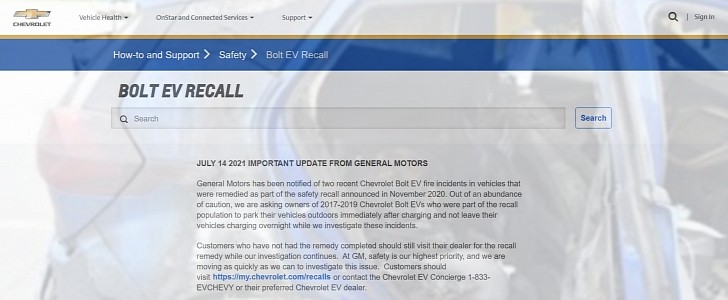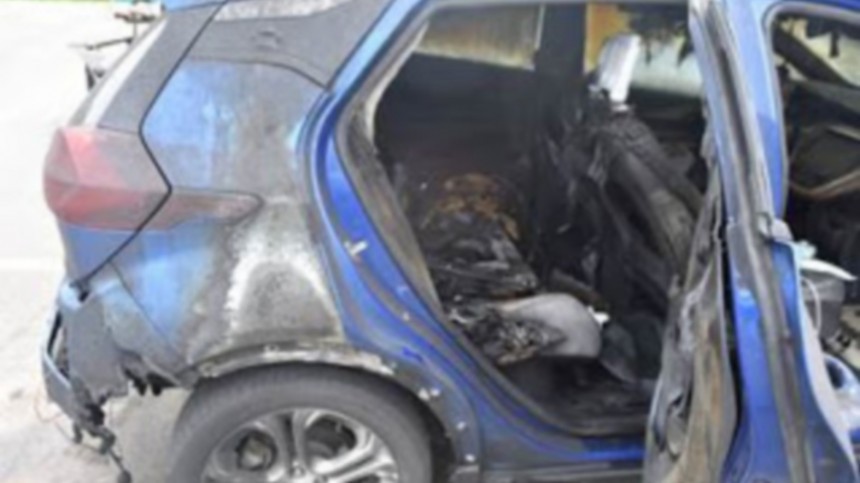GM said this comes out of an “abundance of caution,” but the truth is that it is tacitly admitting that the final Bolt EV recall is not an effective measure to avoid fires. The company is now asking affected owners to park their cars outside and not to charge their vehicles overnight. That would be necessary while GM investigates not one but two blazes in Bolt EVs that have already received the "final" solution for thermal runaways. NHTSA reinforced that request.
If you are not familiar with the issue, the Chevy Bolt EV and the Hyundai Kona Electric faced fire problems related to their batteries, supplied by LGES (LG Energy Solution). On October 7, 2020, Hyundai announced a software update to remedy the situation. GM had experienced at least five fires before it disclosed its recall on November 13, 2020.
At the time, GM said 68,667 vehicles from 2017 up to 2019 model years would be affected by something the company did not disclose because it was supposedly still under investigation. How Hyundai and GM determined the number of affected cars by something no one was sure about is a mystery.
The involved Bolt EVs received a software fix to prevent them from charging to more than 90%. That would be enough to prevent new fires until the investigation was concluded, but they kept happening even to cars that received the patch, such as a Bolt EV in Ashburn, Virginia.
On February 24, 2021, Hyundai announced it would replace battery packs in 75,680 Kona Electrics, 5,716 Ioniq EVs, and 305 Elec City buses, for a total of 81,701 vehicles. Two days later, LGES disputed the issue was a misalignment in the cells caused by a folded anode tab. On March 5, 2021, Hyundai confirmed it was blaming the folded anode tab in cells produced by LGES in its Nanjing factory for the blazes. A recent fire in Norway suggests other vehicles could be affected.
Back to GM, it released what was supposed to be the final recall for the Bolt EV on April 29, 2021. It would consist of an inspection at Chevrolet dealerships and installing “advanced onboard diagnostic software that, among other things, has the ability to detect potential issues related to changes in battery module performance before problems can develop.” GM promised it would replace “battery module assemblies that fail the diagnostics.”
Since then, the “advanced onboard diagnostic software” has failed at least twice. The first case involved Tim Briglin’s Bolt EV, which caught fire on July 1, 2021. GM also disclosed a second fire happened in New Jersey. The company would have learned about it a few days ago.
While Hyundai disclosed what it thinks the cause for these fires was, GM still resists getting into the technical details with the public and the press. That’s probably due to the fact that GM is not only an LGES client, like Hyundai. GM and LGES are partners in the Ultium cell factories in the US, which are the backbone of the American automaker’s strategy for EVs. In other words, GM cannot throw LGES under the bus even if it is ultimately defined as responsible for the fires. So far, that has not been proven. Apparently, nothing has.
Compared to Chevy Bolt EV and Opel Ampera-e owners, people driving Hyundai Kona Electric units at least have the certainty that the defective battery packs will be replaced by components that are free of fire hazards. GM is buying back some affected cars in the US, which is a welcome measure to a situation if failed to solve. Bolt EV owners reported they are not able to sell their cars even for very low prices due to the fire repercussions.
That is just part of why GM still owes its customers an adequate answer for the risk of these cars turning into ashes. Hopefully, these buyers will soon have a solution that is indeed definitive, even if it is just a buyback.
At the time, GM said 68,667 vehicles from 2017 up to 2019 model years would be affected by something the company did not disclose because it was supposedly still under investigation. How Hyundai and GM determined the number of affected cars by something no one was sure about is a mystery.
The involved Bolt EVs received a software fix to prevent them from charging to more than 90%. That would be enough to prevent new fires until the investigation was concluded, but they kept happening even to cars that received the patch, such as a Bolt EV in Ashburn, Virginia.
On February 24, 2021, Hyundai announced it would replace battery packs in 75,680 Kona Electrics, 5,716 Ioniq EVs, and 305 Elec City buses, for a total of 81,701 vehicles. Two days later, LGES disputed the issue was a misalignment in the cells caused by a folded anode tab. On March 5, 2021, Hyundai confirmed it was blaming the folded anode tab in cells produced by LGES in its Nanjing factory for the blazes. A recent fire in Norway suggests other vehicles could be affected.
Back to GM, it released what was supposed to be the final recall for the Bolt EV on April 29, 2021. It would consist of an inspection at Chevrolet dealerships and installing “advanced onboard diagnostic software that, among other things, has the ability to detect potential issues related to changes in battery module performance before problems can develop.” GM promised it would replace “battery module assemblies that fail the diagnostics.”
Since then, the “advanced onboard diagnostic software” has failed at least twice. The first case involved Tim Briglin’s Bolt EV, which caught fire on July 1, 2021. GM also disclosed a second fire happened in New Jersey. The company would have learned about it a few days ago.
Compared to Chevy Bolt EV and Opel Ampera-e owners, people driving Hyundai Kona Electric units at least have the certainty that the defective battery packs will be replaced by components that are free of fire hazards. GM is buying back some affected cars in the US, which is a welcome measure to a situation if failed to solve. Bolt EV owners reported they are not able to sell their cars even for very low prices due to the fire repercussions.
That is just part of why GM still owes its customers an adequate answer for the risk of these cars turning into ashes. Hopefully, these buyers will soon have a solution that is indeed definitive, even if it is just a buyback.







